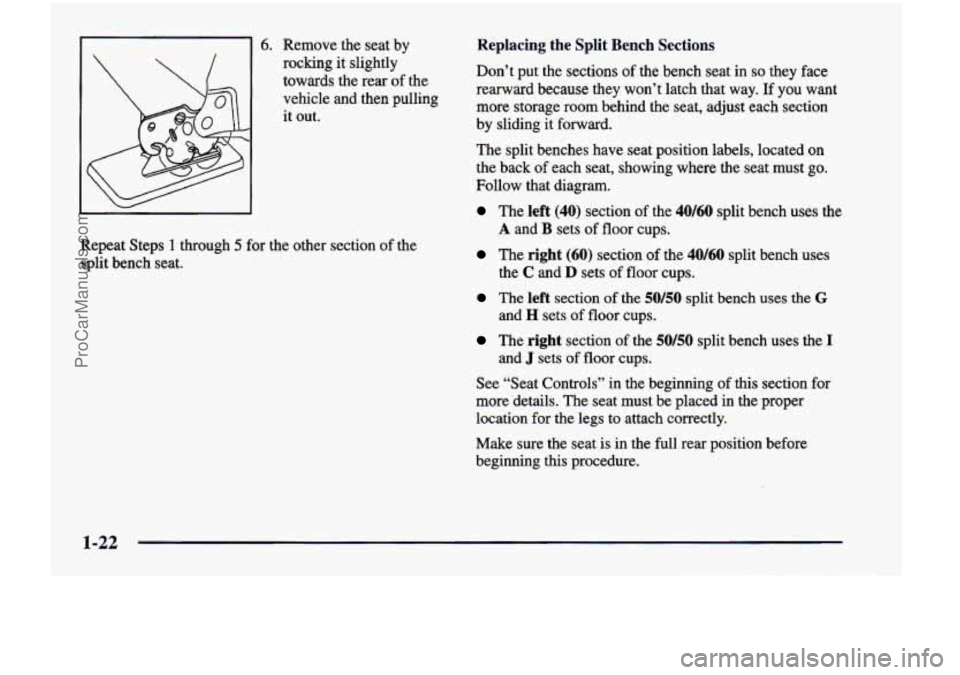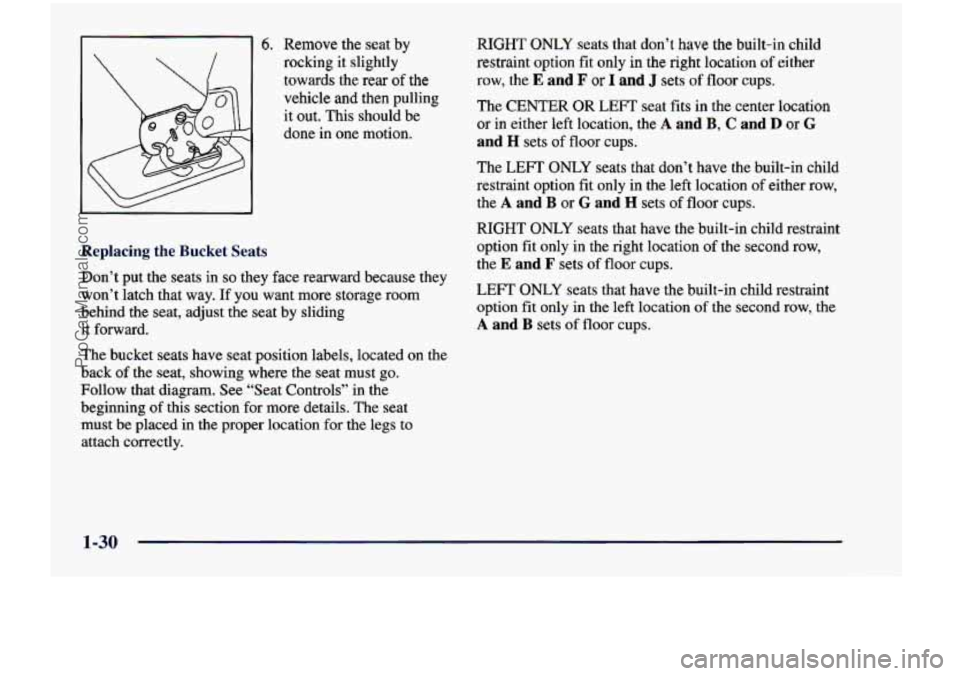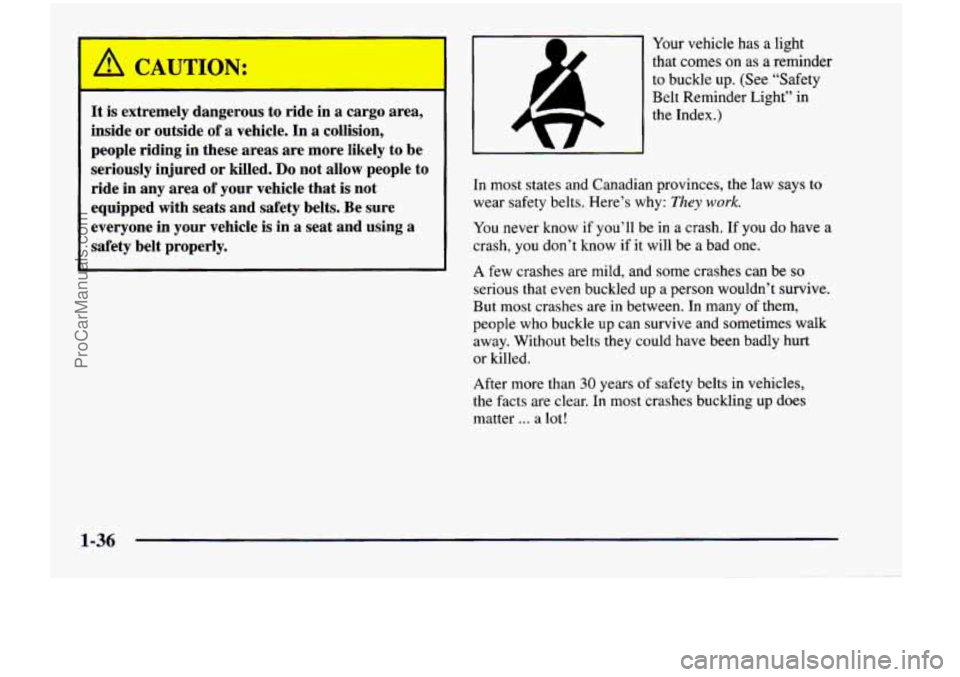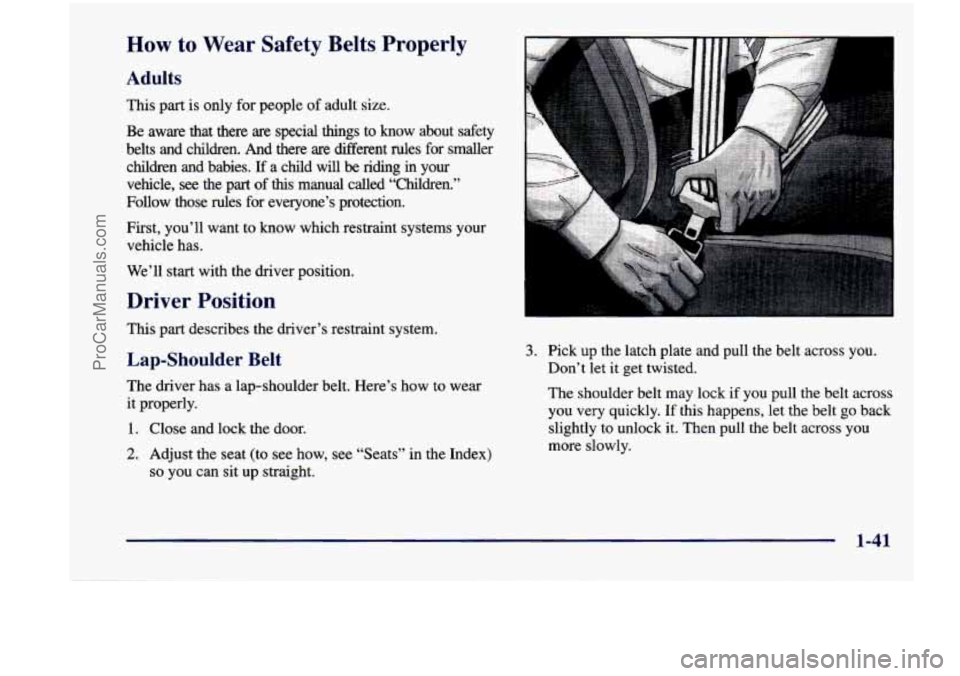Page 13 of 474
Vehicle Symbols
These are some of the symbols you may find on your vehicle.
For example,
these symbols
are used on an
original battery:
POSSIBLE A
CAUTION
INJURY
PROTECT EYES BY
SHIELDING
Q
CAUSTIC
BURNS AVOID
SPARKS
OR
FLAMES
SPARK
OR ,\I/,
COULD FLAME
EXPLODE BA'ITERY
These symbols
are important
for you and
your passengers
whenever your
vehicle is
driven:
DOOR LOCK
UNLOCK
FASTEN SEAT
BELTS
POWER
WlNDOW
These symbols
have to do with
your lamps:
SIGNALS e
TURN
FOG LAMPS
& 0
These symbols
are on some of
your controls:
WINDSHIELD WIPER
WINDSHIELD DEFROSTER
WINDOW
DEFOGGER
VENTILATING FAN
These symbols
are used on
warning and
indicator lights:
COOLANT -
TEMP -
CHARGING I-1
BAllERY
SYSTEM
BRAKE
(0)
COOLANT
a
ENGINE OIL e,
PRESSURE
ANTI-LOCK
(@)
BRAKES
Here are some
other symbols
you may see:
FUSE
LIGHTER m
HORN b
SPEAKER
cr
FUEL B
viii
ProCarManuals.com
Page 23 of 474
t
5. Remove the seat by
rocking it slightly at the
top towards the rear
of
the vehicle and then lift
at the front latch release
lever. This should be
done
in one motion.
I 1. Place the front hooks of
the bench seat onto the
front two floor pins. To
do this, the seat will
need to be angled so that
the front hooks clear the
floor pins.
Replacing the Second Row Solid Bench Seat 2. With the seat still folded forward, roll down the gray
handle underneath the seat to lock the front latches.
Don’t put the bench seat
in so it faces rearward because
it won’t latch that way.
The solid benches have seat position labels, located on
the back of the seat, showing where the seat must
go.
Follow that diagram. Use the A, C and E sets of floor
cups.
See “Seat Controls” in the beginning of this
section for more details. The seat must be placed
in the
proper location for the legs to attach correctly.
1
1-10
ProCarManuals.com
Page 28 of 474
4. Do not let go of the straps until the seat is folded all
the way forward.
, ;q. ......... . . . . . . . . fi
5. Unhook the front latches by rolling up the gray
handle under the seat until the handle
locks.
6. Remove the seat by
rocking it slightly
toward the rear of the
vehicle and then pulling
it out. This should be
done in one motion.
1-15
ProCarManuals.com
Page 35 of 474

6. Remove the seat by
rocking it slightly
towards the rear of the
vehicle and then pulling
it out.
Repeat Steps
1 through 5 for the other section of the
split bench seat.
Replacing the Split Bench Sections
Don’t put the sections of the bench seat in so they face
rearward because they won’t latch that way.
If you want
more storage room behind the seat, adjust each section
by sliding it forward.
The split benches have seat position labels, located on
the back of each seat, showing where the seat must go.
Follow that diagram.
The left (40) section of the 40/60 split bench uses the
A and B sets of floor cups.
The right (60) section of the 40/60 split bench uses
the
C and D sets of floor cups.
The left section of the 50/50 split bench uses the G
and H sets of floor cups.
The right section of the 50/50 split bench uses the 1
and J sets of floor cups.
See “Seat Controls’’
in the beginning of this section for
more details. The seat must be placed
in the proper
location for the legs to attach correctly.
Make sure the seat is in the full rear position before
beginning this procedure.
1-22
ProCarManuals.com
Page 43 of 474

6. Remove the seat by
rocking it slightly
towards the rear
of the
vehicle and then pulling
it out. This should be
done
in one motion.
Replacing the Bucket Seats
Don’t put the seats in so they face rearward because they
won’t latch that way.
If you want more storage room
behind the seat, adjust the seat by sliding
it forward.
The bucket seats have seat position labels, located on the
back
of the seat, showing where the seat must go.
Follow that diagram. See “Seat Controls” in the
beginning
of this section for more details. The seat
must be placed in the proper location for
the legs to
attach correctly. RIGHT
ONLY seats that don’t have the built-in child
restraint option
fit only in the right location of either
row, the
E and F or I and J sets of floor cups.
The
CENTER OR LEFT seat fits in the center location
or in either left location, the A and B, C and D or G
and H sets of floor cups.
The
LEFT ONLY seats that don’t have the built-in child
restraint option fit only in the left location
of either row,
the
A and B or G and H sets of floor cups.
RIGHT ONLY seats that have the built-in child restraint
option
fit only in the right location of the second row,
the
E and F sets of floor cups.
LEFT ONLY seats that have the built-in child restraint
option fit only in the left location
of the second row, the
A and B sets of floor cups.
1-30
ProCarManuals.com
Page 49 of 474

It is extremely dangerous to ride in a cargo area,
inside or outside
of a vehicle. In a collision,
people riding in these areas are more likely
to be
seriously injured or killed.
Do not allow people to
ride in any area of your vehicle that is not
equipped with seats and safety belts. Be sure
everyone in your vehicle is in a seat and using a
safety belt properly.
-1
Your vehicle has a light
that
comes on as a reminder
to buckle
up. (See “Safety
Belt Reminder Light” in
the Index.)
In most states and Canadian provinces, the law says to
wear safety belts. Here’s why:
They work.
You never know if you’ll be in a crash. If you do have a
crash,
you don’t know if it will be a bad one.
A few crashes are mild, and some crashes can be so
serious that even buckled up a person wouldn’t survive.
But most crashes are in between.
In many of them,
people who buckle
up can survive and sometimes walk
away. Without belts they could have been badly hurt
or killed.
After more than
30 years of safety belts in vehicles,
the facts are clear. In most crashes buckling up does
matter
... a lot!
1-36
ProCarManuals.com
Page 54 of 474

How to Wear Safety Belts Properly
Adults
This part is only for people of adult size.
Be aware that there are special things to know about safety
belts
and children. And there are different rules for smaller
children and babies.
If a child will be riding in your
vehicle, see the part of
hs manual called “Children.”
Follow those rules for everyone’s protection.
First, you’ll want to know which restraint systems your
vehicle has.
We’ll start with the driver position.
Driver Position
This part describes the driver’s restraint system.
Lap-Shoulder Belt
The driver has a lap-shoulder belt. Here’s how to wear
it properly.
1. Close and lock the door.
2. Adjust the seat (to see how, see “Seats” in the Index)
so you can sit up straight.
3. Pick up the latch plate and pull the belt across you.
Don’t let it get twisted.
The shoulder belt
may lock if you pull the belt across
you very quickly. If this happens, let the belt go back
slightly to unlock it. Then pull the belt across you
more slowly.
1-41
ProCarManuals.com
Page 65 of 474
There is an air bag
readiness light on the
instrument panel, which
shows a deployed air bag.
The system checks the air bag electrical system for
malfunctions. The light tells you if there is an electrical
problem. See “Air Bag Readiness Light” in the Index
for more information.
How the Air Bag Systems Work
Where are the air bags?
The driver’s frontal air bag is in the middle of the
steering wheel.
1-52
ProCarManuals.com